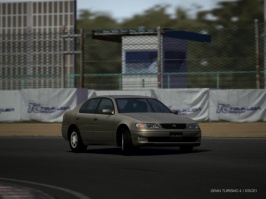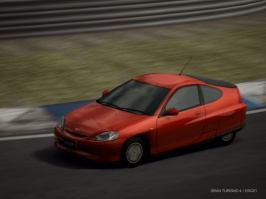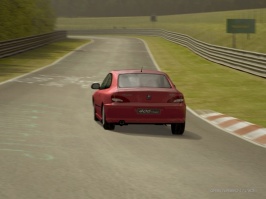- 60

- Germany
It is really amazing how much work you've put into your car reviews. They are a blast to read. Thank you a thousand times 






Reading this in hindsight, your observations when comparing the Castrol '00, Au Cerumo '01 and Woodone '03, along with JGTC's as a whole, were actually spot-on. A few key differences you might be interested in, obtained by querying SpecDB:
Car: Toyota au Cerumo Supra (JGTC) '01*
Status: New
Price: 1,350,000 Cr.
Engine: L4 DOHC, 1998 ccm
Power: 463 hp @ 6000 rpm
Torque: 637.41 Nm @ 4500 rpm
Aspiration: Turbo
Drivetrain: FR
Weight: 1100 kg
*the review requested by @All Your Base
Driven by Yuji Tachikawa and Hinori Takeuchi, the Cerumo won 2001 JGTC season. It must have been a difficult battle, with two following teams being in tie two points below the Cerumo. I was recently told how the newest JGTC machine featured in GT4, Woodone Tom's Supra, is trying to steal all the limelight of previous JGTC champions, so today we are going to find out what can be done to convince players not to forget about previous achievements.
However, before I proceed with Cerumo VS Woodone comparison, I'm going to face the Cerumo against older JGTC machine, the Castrol Tom's Supra '00.
Cerumo '01 VS Castrol '00
The Castrol suffers from mild understeer on both corner entries and exits. Upon accelerating, understeer is being delivered in temporal package which disappears once the weight stops moving around the car. Nothing unusual in this game, but it can be annoying if you don't know how to cure it via suspension tuning. Sudden acceleration release on mid and high-speed corners may also invoke certain amount of understeer. In general, caution is required on corners.
The Cerumo inherits the same characteristics, albeit with one big improvement; upon going out of a corner, there is more diligence to cope against cornering forces and bring the car out without taking risk to collide with outer wall, which would often happen with the Castrol on High-Speed Ring. In other words, the Cerumo's cornering is tighter, those lines are going to increase your speed on the way out. That understeer during deceleration is not that sensible either and it seems major improvements for the 2001 season have been made on aerodynamics too, given how the Cerumo is always 2 per 3 kph faster than the Castrol.
One could think how these two cars are completely identical due to copy-pasted hp and kg values, but once you carefully test each, you'll find out how the Cerumo is quite faster than the Castrol; On very first lap I had no problems beating Castrol's time for half second, while every additional lap would shave another mini-amount of my lap. Blast!
Cerumo '01 VS Woodone '03
Now we are discussing improvements that don't hesitate to affect both visual and even audio sensors of yours. The Woodone introduces new body, new exhaust sound (which I find more enjoyable) and different power delivery; with around 490 ponies, the Woodone is very close to what GT500 standard prescribes. Torque has been reduced a bit, but I never tested acceleration of both cars, so I can't tell if this would make any difference. Engineers obviously found a way to increase potential of newest JGTC competitors - we are not talking about 8 to 10 kph difference on straights over the Cerumo. And because the cornering potential has remained the same, the Woodone is definitely faster than the Cerumo. You can somehow keep up on corners, but once you reach speedy section, the Woodone will slowly, but dangerously run away from the Cerumo. I almost managed to download entire second of the Cerumo's time.
Surprisingly, at one point I felt that you need to spend more time braking or decelerating with the Woodone than with the Cerumo. Since this isn't side effect of the additional speed, I went to Hong Kong to see where the problem lies. And then I realized: The Cerumo owns better turn-in on sharp corners and even more grip on rear end when trying to pull away from sharp corner. That doesn't mean the Woodone is bad, but it requires different driving style to tackle sharp corners. Entering a corner while brakes are applied is recommended as that will increase its speed trough corners. The Cerumo can use its brake sooner and then allow its turn-in ability to enter corner as sharp as possible.
The latest generation of JGTC Supra machines was obviously built for comfortable, speedy driving where understeer is well concealed, allowing driver to increase turn-in potential by himself. Still, once your opponent perceive this, the Cerumo won't have any chances.
In other words, on the Woodone you're are encouraged to work on better turn-ins while the Cerumo will requires methods for reducing understeer.
To conclude, newer JGTC machines will always have the edge over older ones, even if manufacturer values do not imply such possibility. However, once people start comparing JGTC versions of the same year, the overall visual impression will probably determine level of popularity one model will get in comparison with others. This could be the answer to question regarding popularity of the Cerumo model; unusual solutions on headlights and taillights are probably annulling potentially interesting livery the car provides to please your eyes.
Verdict:
+ Noticeable orange traces will successfully mark the winner on the grid.
- Some '01 JGTC Supra models have more attractive exterior.
The game's internal database which contains all of the physics data for every car. It's not in a standard format in the game's files, but you can download a more readable copy here. This contains mapping of all the data our team of modders understands about the game and can be opened with any tool that can browse SQLite databases such as SQLiteStudio or DB Reader for SQLite.Whoa, where did you get the table from? It's amazing, that's the first time I see it.
I never wanted to accept at the time existing suggestions that all in-game JGTC models were the same, but these numbers explain this is indeed true, and that differences are quite important. You're right, choosing and tuning your car based on that info would be much more enjoyable. The info we get is scarce and doesn't serve the complexity of the physics engine well enough.
Even though I always prefer focusing on feelings and joy during each test drive, I sometimes feel it could be helpful to explain why the car handles the way it does. This table is a step closer to giving the right answer.
Thanks for the post and the link. I have not been around GT4 for a while, I just may pick it up again.

Acceleration: 0-50 kph in seconds
Fiat-206-Polo
3.1-2.9-3.0
5.0-5.0-5.1Acceleration: 0-100 kph in seconds
Fiat-206-Polo
8.8-8.5-8.9
12.0-11.4-13.1Acceleration: 0-130 kph in seconds
Fiat-206-Polo
14.5-13.8-14.6
18.9-17.4-21.0Elasticity 60-100 kph (4th gear) in seconds
Fiat-206-Polo
8.1-8.0-9.2
9.7-8.8-10.4Elasticity 80-120 kph (5th gear) in seconds
Fiat-206-Polo
13.8-11.4-12.8
15.9-11.4-14.2Max speed in kph
Fiat-206-Polo
205-210-205
198/NDF-202/208-195/202Braking: 100-0 kph in metres
Fiat-206-Polo
43.5-38.1-40.5
31.2-31.4-33.5Range in kilometres
Fiat-206-Polo
520-530-490
221-211-249Measured HP and weight in kg
Fiat-206-Polo
130-135-125
1120-1055-1125
127-136-121
1100-1080-1090Tsukuba Lap Times (N2 tires, no assist):
1'16.002 - 206
1'17.802 - Punto
1'18.610 - Polo
Journalists times (unknown track):
1'53.17 - 206
1'55.51 - Punto
1'56.63 - PoloThe French goes like a storm and constantly repeats the attack on the Bastille. Poisonous, lustful, powerful.
It delivers a shameless amount of power in every rev range and, like a bull terrier, it never backs off.
The hard-tuned suspension of the 206 registers every unevenness of the surface, but on the circular track it takes care of pleasure with a rating of ten.
With direct steering, the French flea moves easily and lightning fast around the corner, without noticeable understeer or rocking.
But be careful. Whoever hesitates when cornering and puts his foot from the gas to the brake in fear, must (especially in the wet) be alert and heartily counter with the steering wheel. Otherwise, the rear end of the Peugeot takes the lead and makes unwanted turns. Even good brakes don't help here.
The Polo is insanely safe, almost boring going through the slalom course. Slight slides over the front wheels and a noticeable tilting of the body make it dull overall.
Driving the Fiat brings less joy.
Hard suspension, unbalanced damping, weak brakes.
The high compressive hardness of the shock absorber is a severe test for the spine, while the low tensile hardness causes the body to sway uncomfortably after bumps and in turns.
When dodging, Punto’s rear end gets carried away strongly, and it is difficult to control it with the sluggish steering wheel. Mamma mia!
I noticed the briefer the journalists’ sentences get, the closer the virtual cars resemble their real-life models. That means Polyphony succeeded in capturing the most important fundamentals, in spite of making some mistakes here and there.Peugeot's victory is surprising only at first glance. Powerful engine and agility make it number one among mini sportsmen. Insanely safe and expensive VW Polo lacks sportiness, while Fiat's cheap Punto loses points due to unbalanced chassis.
